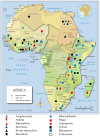Systematic Review of Important Bacterial Zoonoses in Africa in the Last Decade in Light of the 'One Health' Concept
- PMID: 30995815
- PMCID: PMC6631375
- DOI: 10.3390/pathogens8020050
Systematic Review of Important Bacterial Zoonoses in Africa in the Last Decade in Light of the 'One Health' Concept
Abstract
Zoonoses present a major public health threat and are estimated to account for a substantial part of the infectious disease burden in low-income countries. The severity of zoonotic diseases is compounded by factors such as poverty, living in close contact with livestock and wildlife, immunosuppression as well as coinfection with other diseases. The interconnections between humans, animals and the environment are essential to understand the spread and subsequent containment of zoonoses. We searched three scientific databases for articles relevant to the epidemiology of bacterial zoonoses/zoonotic bacterial pathogens, including disease prevalence and control measures in humans and multiple animal species, in various African countries within the period from 2008 to 2018. The review identified 1966 articles, of which 58 studies in 29 countries met the quality criteria for data extraction. The prevalence of brucellosis, leptospirosis, Q fever ranged from 0-40%, 1.1-24% and 0.9-28.2%, respectively, depending on geographical location and even higher in suspected outbreak cases. Risk factors for human zoonotic infection included exposure to livestock and animal slaughters. Dietary factors linked with seropositivity were found to include consumption of raw milk and locally fermented milk products. It was found that zoonoses such as leptospirosis, brucellosis, Q fever and rickettsiosis among others are frequently under/misdiagnosed in febrile patients seeking treatment at healthcare centres, leading to overdiagnoses of more familiar febrile conditions such as malaria and typhoid fever. The interactions at the human-animal interface contribute substantially to zoonotic infections. Seroprevalence of the various zoonoses varies by geographic location and species. There is a need to build laboratory capacity and effective surveillance processes for timely and effective detection and control of zoonoses in Africa. A multifaceted 'One Health' approach to tackle zoonoses is critical in the fight against zoonotic diseases. The impacts of zoonoses include.
Keywords: Africa; One-health; Zoonosis; animals; antibiotics; antimicrobial resistance; bacteria; epidemiology; livestock.
Conflict of interest statement
The authors declare no conflicts of interest.
Figures



References
-
- Simpson G.J., Quan V., Frean J., Knobel D.L., Rossouw J., Weyer J., Marcotty T., Godfroid J., Blumberg L.H. Prevalence of selected zoonotic diseases and risk factors at a human-wildlife-livestock interface in Mpumalanga Province, South Africa. Vector-Borne Zoonotic Dis. 2018;18:303–310. doi: 10.1089/vbz.2017.2158. - DOI - PubMed
-
- Grace D., Mutua F., Ochungo P., Kruska R., Jones K., Brierley L., Lapar M., Said M., Herrero M., Phuc P. Mapping of Poverty and Likely Zoonoses Hotspots. ILRI; Nairobi, Kenya: 2012.
Publication types
LinkOut - more resources
Full Text Sources
Miscellaneous

